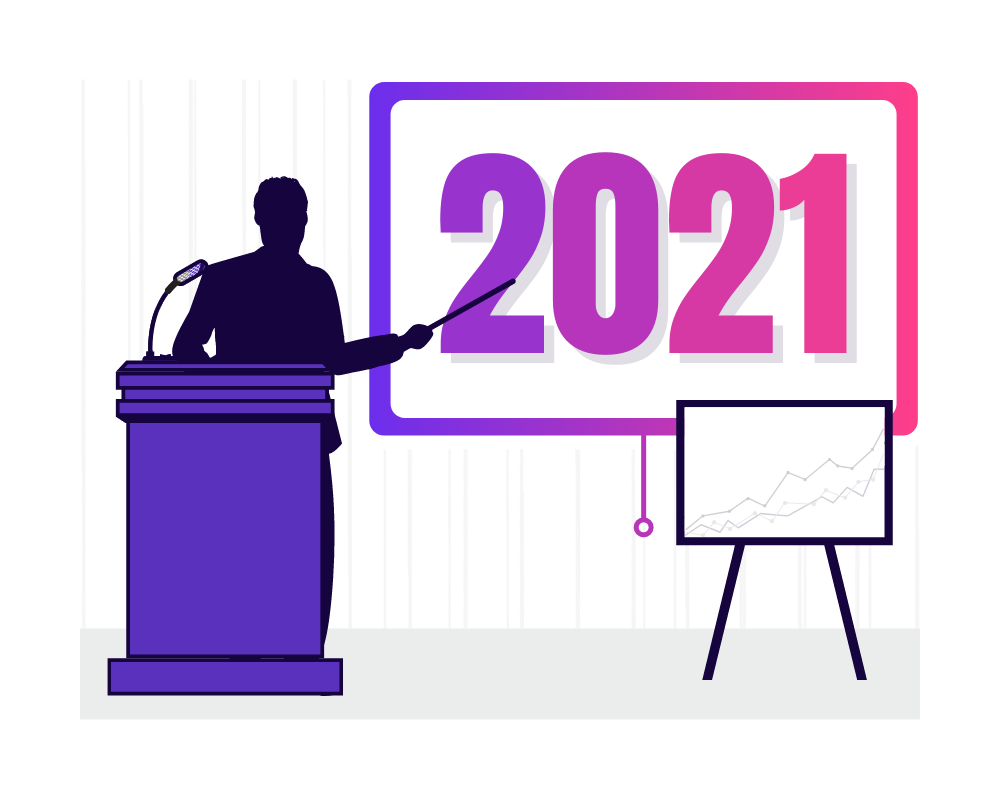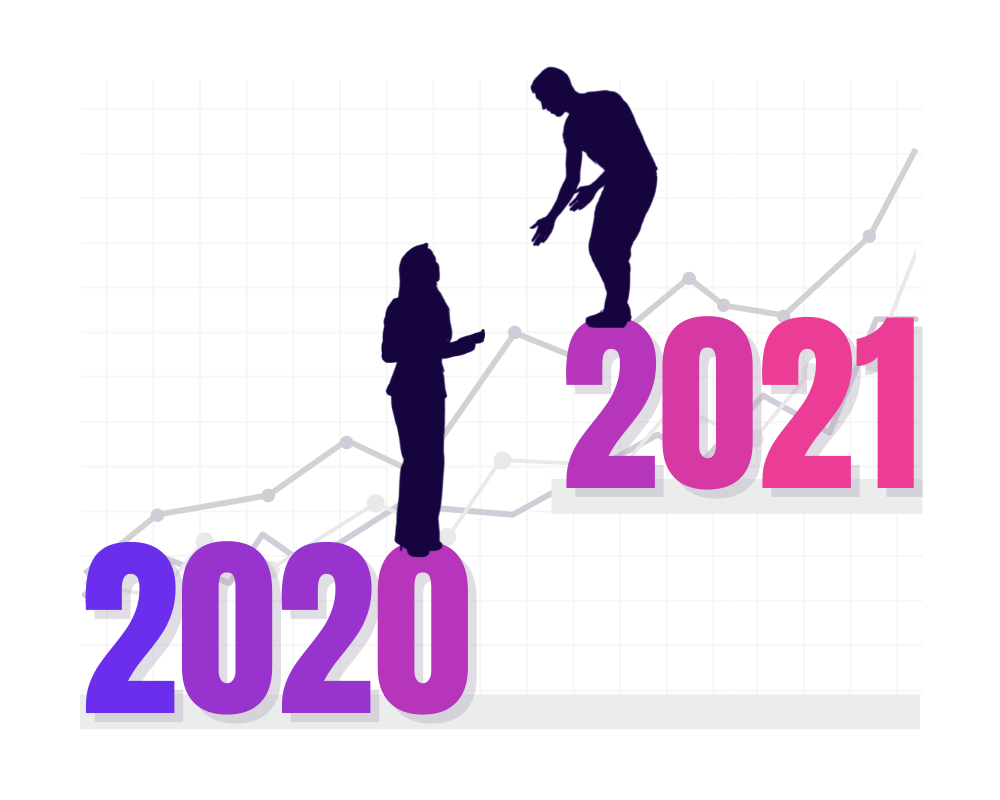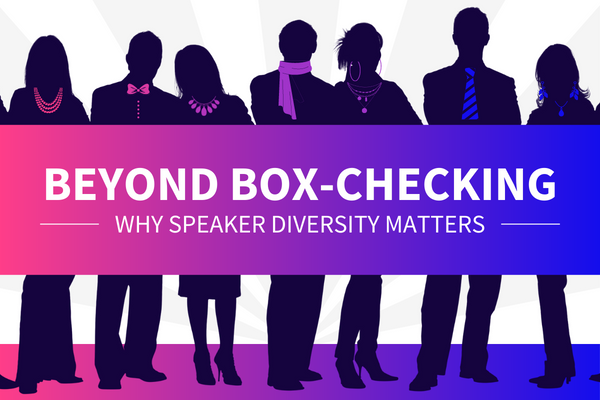If 2020 was a whirlwind, then 2021 was a downright hurricane. Despite new challenges, the public speaking space continues to evolve and adapt. These changes were an opportunity for new thought leaders to stand out and shine. Whether you’re a speaker yourself or considering expanding your business, it’s important to have a strong understanding of the latest public speaking statistics.
At SpeakerFlow, we break down industry changes by year. This gives us the flexibility to examine changes and developments side-by-side, predicting what’s on the horizon. Not only have audience expectations changed in 2021, but speakers are managing these new challenges with grace and open-mindedness. By speaking to speakers about their businesses throughout the previous year, we learn how they’re feeling, adapting, and making their businesses stronger.
Though the pandemic threw a major wrench in the world of public speaking, the industry itself came back stronger than ever in 2021. By examining the latest public speaking statistics, you can adjust your own processes and plans. Today’s businesses need to be adaptable, light on their feet, and ready to take on new challenges. Ultimately, the SpeakerFlow State of the Speaking Industry 2022 Report reveals big changes ahead, but these don’t have to be intimidating.
In this industry-wide snapshot, we’ll review the past year of public speaking in 2021. More importantly, we’ll identify key takeaways, helping current and new speakers develop their 2022 strategy. If you want to stay ahead of the curve when it comes to public speaking, this guide is your new best friend. It doesn’t matter if you’re just getting started or you’re several years in your business, these stats will help. 👍
2021 Overview Of Public Speaking
First, let’s take an overview look at the state of public speaking throughout 2021. After the COVID-19 pandemic, speakers of all backgrounds worked to rebuild their business in 2021, and the pandemic affected everyone, regardless of speaking experience or background. Of those surveyed, the average participant had between 9 and 12 years of public speaking experience. Similarly, the average years spent operating as a speaking business is 10. The majority of these speakers have already undergone significant growth, but there’s still room to grow. Though these speaking businesses were established, there was still room to grow and develop.

Interestingly enough, the number of public speakers who grew teams in 2021 was on the rise. This past year, only 67% reported themselves as solopreneurs with no team. More respondents in the past year had added at least one team member. In fact, the average team member for public speaking businesses rose from two to three members. Believe it or not, over 10% have 10 members or more on their team. This shows that public speakers are investing back into their business, and they’re not afraid to outsource skills when needed.
Despite many speakers having to take time off in 2020, sales are on the rebound. Speakers and thought leaders are prepared to make big changes to adapt to today’s demands. While many are still doing many of the business tasks themselves (ie. solopreneurs), there’s a growing percentage of public speakers looking to outsource to other qualified professionals. With many speakers shying away from sales, marketing, and content creation, it’s important to have a process to handle these important tasks. Not only does this free speakers to focus on the parts of their business that earn them money, but it can also boost their overall efficiency.
Key Takeaways
- More speakers (33%) are hiring help, whether employees or contractors. This means they’re investing funds into their business, growing their productivity and reach. On average, most teams have 3 team members.
- The majority of public speakers rate their ability to sell as a 6/10 or higher. Despite this, public speakers are continuing to outsource their sales process to sales experts. This is likely because many of today’s speakers are anxious about sales, even if they’re confident in selling. Some of the commonly cited reasons for sales anxiety include no past sales experience, imposter syndrome, and a fear of talking about price.
- Public speakers are less sure when it comes to marketing their businesses. The average speaker rated themselves a 4.5/10, dropping from previous years. Still, speakers today are optimistic about the future.
2021 vs. 2020 Public Speaking
With that overview in mind, how does the past year (2021) compare to the previous year of public speaking (2020)? Simply put, 2021’s sales stats were very similar to the year before. The average public speaking professional delivered between 10 and 15 paid speaking gigs in both years. Though these numbers are similar, it’s important to note that fewer speakers reported delivering free gigs in 2021 with 62% delivering less than 5 free gigs (vs. 51% in 2020). This is good news, demonstrating recovery after COVID.

Though many speakers (particularly new ones), felt compelled to speak for free to promote themselves through the challenges of 2020, this is no longer the case. According to today’s public speaking statistics, speakers are no longer settling for low speaking fees or unpaid gigs. This bodes well for the industry as a whole and, again, demonstrates further post-COVID recovery.
However, this doesn’t mean the industry is completely in the clear. The majority of speakers in the past year charged under $5,000 per gig (65%). Though this number is down from 70% in 2020, speakers still hear a lot of feedback about budget concerns with a reported 61% citing them as the most common objection from potential clients. Still, 3% more speakers in 2021 were charging in the upper range of fees ($10,000 to $20,000). We can take this as a sign that, on average, public speakers are charging more per gig.
Overall, the income and revenue are similar between 2021 and 2020. Professional speakers can expect to earn between $50-75,000 annually, although not exclusively from speaking. While 37% of public speakers earned revenue through keynoting, workshops and digital products continued to gain popularity, and there are many underutilized sales offerings (membership sites, retreats, and breakout groups, for example).
Key Takeaways
- Public speakers feel more confident charging more for their expertise than in past years. Additionally, they’re less likely to speak for free. Still, there’s a fear around talking about money or price when selling speaking services. Many speakers, even those with a lot of experience, worry about imposter syndrome.
- The majority (65%) of professional public speakers get business through word-of-mouth referral marketing. Referrals and past clients have never been more important, leading to 70% of speakers today using some form of referral marketing to source leads.
- Despite there being more options for self-generated revenue, only 30% of speakers in 2021 earn revenue through their own lines of income (courses, books, products, etc). Though some alternative streams of income are on the rise, they’re still highly underutilized by speakers.
2021 vs. Pre-COVID Public Speaking
Next, it’s impossible to talk about the state of public speaking statistics in 2021 without talking about the impact of COVID. The pre-COVID world was a different place, and it’s impossible to understate how it changed the industry. The good news, however, is that things are looking better in 2021 than in 2020, and an average of 30% of gigs in 2021 were canceled due to COVID (vs 40-50% in 2020).

That said, revenue was still a very real concern for public speakers. In fact, according to 2021’s public speaking statistics, the majority (49%) of speakers experienced a dramatic decrease in revenue. When you consider that the average speaker invested upwards of $1,000 in their home studio, the loss of revenue becomes a bigger concern. However, only 4% of speakers closed their business altogether, showing just how resilient this industry is.
One example of such resilience was speakers’ continued focus on virtual programs. In 2021, speakers reported 60-70% of their gigs were completely virtual compared to 40% in 2020. Speakers continue to push for more diverse forms of revenue as a way to create a stable source of income outside of speaking. By offering digital products, services, and marketing, they attract a wider audience beyond speaking gigs. Though live events are likely to return in greater frequency, it seems these changes are here to stay.
Predictability is key in a post-COVID world. Up from 13%, a striking 30% of professional public speakers earn revenue from self-generated sources. Having a reliable source of income has never been more important, and more speakers recognize the value of not having to constantly seek opportunities. Similarly, 30-40% of speakers source revenue from repeat clients, so there’s an industry-wide trend of long-term relationships vs. the endless loop of chasing leads.
Key Takeaways
- Despite more anxiety about long-term revenue, the percentage of speakers earning over $75,000 per year is on the rise (up 9%). With the average speaker participating in 10-15 gigs on average, new forms of revenue make it possible to create greater income potential.
- To build a long-term business model based on referrals and word-of-mouth, speakers are increasingly focusing on content marketing. By positioning themselves as thought leaders, 65% of speakers attribute most of their businesses solely on referrals.
- Building an efficient home studio has been one of the biggest goals of 2021 since virtual and hybrid events are here to stay. This includes investing in equipment like microphones, soundproofing, and more. An investment in tech tools like CRM platforms, social media schedules, and more continues to be a priority.
How You Can Stay Ahead Of The Curve
Ultimately, today’s public speaking statistics reveal the importance of staying ahead of the curve. With 67% of speakers acting as solopreneurs, you’re your own biggest advocate. By being proactive about your own skills, reflecting on the state of the industry, and growing your sources of income, speakers can find more stability and success long term.
With that in mind, what are some real-world ways to take your business further? First, position yourself as a thought leader and expert. No matter your industry, you have an area of expertise that helps you stand out. This is why your clients trust you, and it attracts future leads to your content and services. From there, embrace technology. If there’s one thing we can learn from the pandemic, it’s that hybrid and virtual events are here to stay. The more adaptable you are to today’s technology, the easier it is to shift your business when needed.
Because things are so unpredictable, it’s never been more essential to have a central plan and process. What are your quarterly, yearly, and long-term goals? You won’t grow your business if you’re simply guessing what comes next. You need values, visions, and goals. This gives you the foundation to create systems that help you work smarter not harder. For example, you might hire a sales professional, consider a speaker agent, or use a dedicated speaker CRM.
Are you ready to embrace the journey as a public speaker? There’s a lot we can learn from these public speaking statistics from 2021 that apply to the world of 2022 and beyond, and no one thing is going to bring you overnight success. Instead, you need to stay disciplined in your marketing, sales, and goals. As long as you keep sight of what’s driving your business, you’re sure to succeed.





